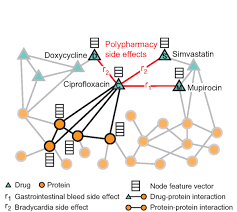
Popping in many medicines as per Doctors’ instructions is as normal as sipping tea/coffee from a cup. Across the globe millions of people take more than five medications a day but testing the side effects of such combinations is practically not possible. But with the arrival of Artificial Intelligence computer scientists at Stanford have made an effort to predict side effects of various drug combinations. As per CDC estimate in the month of March alone 23% of Americans took two or more prescription drugs. Of the people above 65 years of age, 39% take five or more prescription drugs which by the way has increased three fold in the last many decades.
The surprising part is that in many cases doctors do not have any idea what side effects may arise from adding another drug to a patient’s personal pharmacy. Taking these revelations seriously, computer scientists at Stanford started working in this direction. On July 10, 2018 at the meeting of the International Society for Computational Biology , Chicago, Zitnik and his colleagues Monica Agrawal, a Master’s student and Jure Leskovec, an Associate Professor of computer science presented a paper in which they described Artificial Intelligence not just for tracking but also predicting the potential side effects arising from different drug combinations. They called the system “Decagon” that could help doctors in making informed decisions regarding which drugs to prescribe in which combinations and also aid researchers to find better combinations of drugs to treat complex diseases. This research was supported by the National Institutes of Health, National Science Foundation, the Defence Advanced Research Projects Agency, the Stanford Data Science Initiative and the Chan Zuckerberg Biohub.
Sadly as of now it is more of a matter of chance what side effect/effects a patient has when he takes different drug combinations but once Decagon is available to doctors in a more user-friendly way, Decagon’s predictions would be of advantage. There are nearly 1000 known side effects and 5000 drugs on the market which makes almost 125 billion possible side effects between all possible pairs of drugs. Unfortunately most of these combinations have not been systematically studied thus not prescribed too.

So these scientists started by studying how drugs effect the underlying cellular machinery in the body. They created a massive network to describe how more than 19,000 proteins in a human body interact with each other and how different drugs effect these proteins. The team then used more than 4 million known associations between drugs and side effects to design a method to identify patterns in how side effects arise based on the fact how drugs target different proteins in our body. To further take up their study the team used Deep Learning which is a kind of artificial intelligence modelled after the brain to look at complex data and extract from it the abstract, sometimes counterintuitive patterns in the available data.
The researchers designed their own system to read patterns about the side-effects of various drug interactions and predict previously unseen results from taking two drugs together. Then the team wanted to validate their observations which were predicted by Decagon and see if they were true. Surprisingly in many cases, they did come true. For example, in the collected data there was no indication that Atorvastatin, a cholesterol medicine and Amlodipine, a blood pressure medicine could lead to muscle inflammation. Yet Decagon predicted that it would and it proved to be true. As the team kept progressing with their study it was seen to be true in other cases as well. The team also searched the medical literature for evidence of 10 side effects predicted by Decagon and to their surprise five out of the ten had recently been confirmed, further giving impetus to their efforts regarding Decagon.
Presently, only the side effects associated with pairs of drugs are being considered by the researchers and in the future they intend to include more complex combinations of drugs. They also want to create a more user-friendly tool that can be given to doctors with an intention to guide them on whether it is a good idea to prescribe a particular drug to a particular patient who is suffering from a complex disease and aid researchers to develop drug regimens for complex diseases with lesser side effects. As per the team as of today it is sad to know that most of the side effects of drug interactions are discovered essentially by accident and they feel their work has the potential to give way to more safer and effective patient care.
SOURCE: news.stanford.edu

